|
Osprey Reef is one of the most isolated dive sites in Australia, located over 340 kilometres from the nearest city, Cairns. It is 311 kilometres north-west of Port Douglas where most of the boats that visit this remote location depart from. ON most dive trips here, the boats work their way up the Ribbon Reefs till they can make an easy (well, relatively easy) passage across the 135 to 150 kilometres of open ocean (the Coral Sea) to Osprey Reef. It is about 200 kilometres from the mainland.
The reef itself basically runs from north-west to south-east and is about 30 kilometres long and 10 kilometres wide. There is a single decent entrance to the only lagoon (which is about 25 to 27 metres deep for the most part) that is located about two thirds of the way from the southern point to the northern point. Boats steam to Osprey from the Great Barrier Reef overnight, with most boats taking about 10 to 12 hours depending on the conditions and where you are leaving the main reef.
Nearly all the dive sites at Osprey are on the north-eastern section of the reef as this is the most protected from the predominant south-easterly winds and seas. Cobalt Caves is located about 3.1 kilometres north of Raging Horn (that is, about one-third of the way from Raging Horn to North Horn (the most northerly point of the reef). The GPS location of the site is S13° 51' 50.5" E146° 33' 27.8" using WGS84 as a datum (see my GPS page from left menu for what this means).
 | 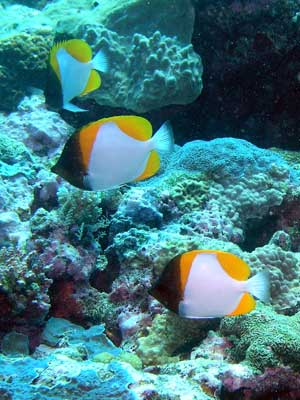 |
| A huge barracuda we saw on the sand | Some butterflyfish at Cobalt Caves |
The mooring at this site is attached to the main reef at about seven metres. The site consists of a series of coral bommies that reach up to within a few metres of the surface and then there is a sandy slope to about 35 metres and a shear wall to much greater depths (it is over 400 metres deep just off the main reef).
Once you enter the water, drop straight below the boat to the sand below. You will soon see the coral bommies. At the location of the mooring, the slope is quite steep and the dropoff very noticeable. You will see that the mooring is on a very large bommie. To the south there is a "river" of sand that seems to flow from between this bommie and the next. Cross over this sand and follow the bottom of the next bommie. There are not many gorgonias along here but there are some nice sea whips and hard coral trees. Keep an eye out over the deep water as you will probably see some white tipped reef sharks and possibly barracuda. There may also be grey reef sharks and some eagle rays.
At the next "river", turn left and follow it shallower into the gully between the bommies. Behind this bommie there is another gully that runs parallel to the main reef. If you follow this you will see that it comes to yet another gully that is at right-angles to the main reef. Cross this and contiue to the next gully which is not that far away. If you follow this to the west (right) back towards the deeper water you will come out on a huge sandy plateau. This appears to run out for at least 50 metres before it presumably comes to the main dropoff. On the sand we found a lone (and very large barracuda) and you are also likely to see more sharks and possibly rays.
 | 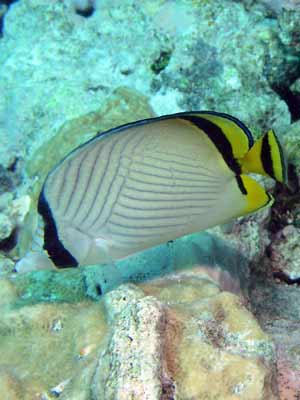 |
| One of a number of white-tipped reef sharks we saw in the gullies | One of many Gunthers butterflyfish
seen at Cobalt Caves |
Once on the sandy plateau, head north along the reef edge till you come to the next gully. We found a number of white-tipped reef sharks in this gully resting on the sandy bottom. We went up this gully and back down the gully that we had already come down. This then goes behind the main bommie. Once you reach the northern side of the main bommie you will see that there is another "river" of sand that flows down from the reef. This one is much wider than the other one, being at least 30 metres across. On my dive here there was a decent current coming down this gully as water flowed from inside Osprey Reef to the open ocean.
 |  |
| A firefish seen in one of the gullies | An elusive clown triggerfish
that was not keen on getting his photograph taken |
Instead of heading up this main gully, we went up another smaller one that ran at 45° to it. This had little current and was quite interesting. On the left there was a large bommie and this had a smallish cave in it. A couple of people could go in at the same time and you could see though the other end back to the gully but it was too cramped to try to get through. Back in the gully, we swam to the end and joined back on the main "river". We came back down this using the current and at the start of the gully behind the main bommie, rejoined this gully.
This gully up higher had some largish caves that could fit a few people. This give good photo opportunites as there are some nice red sea whips in some of them. There are also some small swim-thoughs along some of the gullies. We also found some clownfish on an anemone near the mooring. These clownfish had recently lay some eggs and they were right next to the anemone on the dead coral. From experience, this are only there for a few days before they hatch.
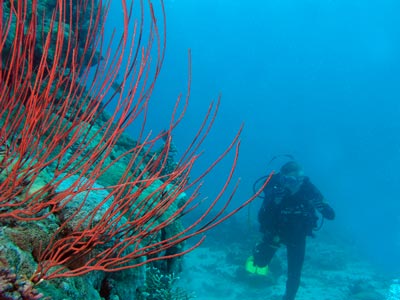 |  |
| Clint Emmett and some of the sea whips on the main wall | A clownfish and at right, the clownfish eggs |
To finish off the dive, we spent a considerable period on the tops of the many bommies. There are lots of small tropical species here like butterflyfish, firefish, trevally and surgeonfish.
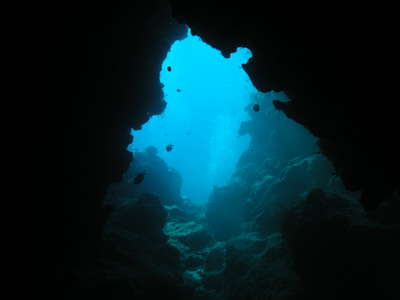 | 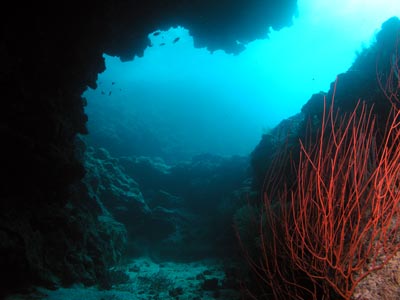 |
| Two of the many caves at Cobalt Caves |
This is not as good a site as some of the other locations at Osprey Reef, but it was interesting just for the many gullies and caves and the finding of the clownfish eggs made it a bit better. Water temperature in October was 26°C and the visibility was a little worse than the other sites here, perhaps only 20 metres (presumably due to the water running out of the reef's lagoon).
Click here to return to the Osprey Reef article page.
| 
 v6.00.307 © 2003-2005
v6.00.307 © 2003-2005